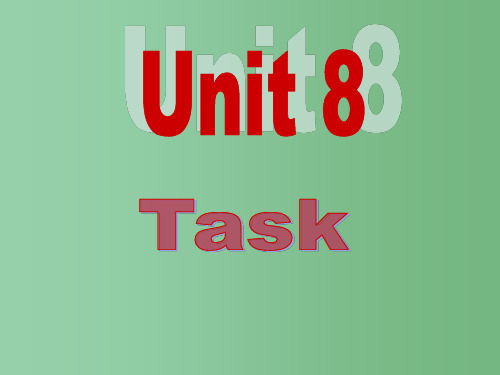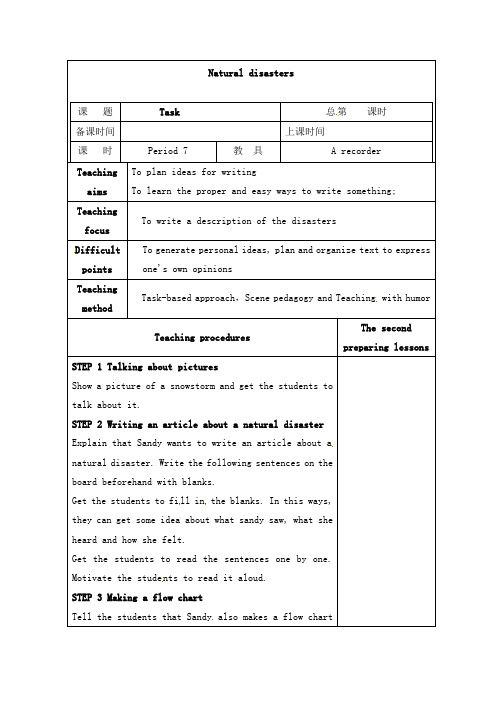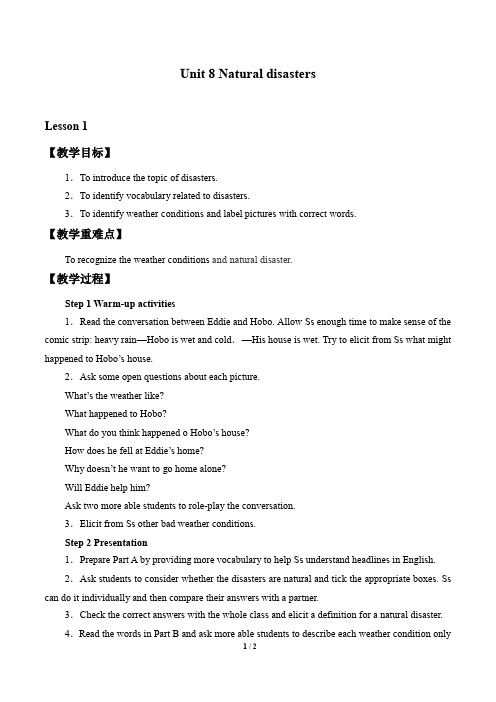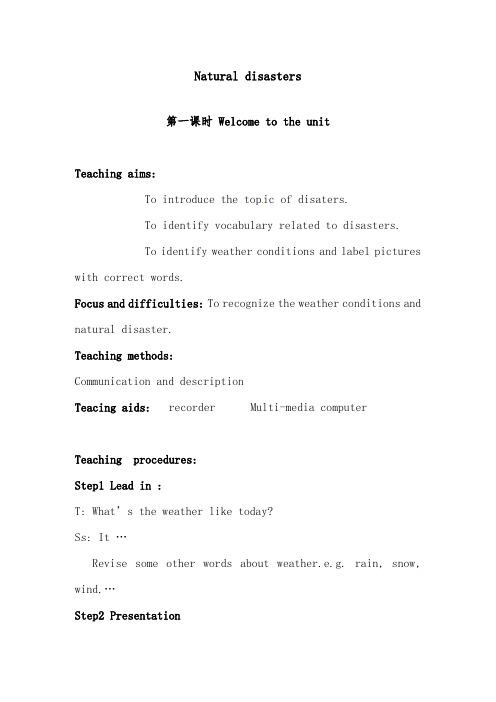八年级英语上册 Unit 8 Natural disasters优秀教案 (新版)牛津版
- 格式:doc
- 大小:208.00 KB
- 文档页数:2

牛津译林版八年级上册Unit 8《Natural disasters》(Reading 2)说课稿一. 教材分析《牛津译林版八年级上册Unit 8 Natural disasters》的Reading 2部分主要介绍了龙卷风的发生原因、特点以及给人们带来的危害。
文章通过讲述一个发生在龙卷风中的真实故事,让学生了解和认识这一自然灾害。
文章语言简练,内容丰富,贴近学生生活,能够激发学生的学习兴趣,培养他们关爱生命、敬畏自然的意识。
二. 学情分析八年级的学生已经具备了一定的英语基础,能够听、说、读、写简单的英语句子。
但他们在阅读理解方面还存在一定的困难,特别是对于长篇文章的理解和分析能力。
此外,学生对于龙卷风这一自然灾害的了解并不深入,因此需要在课堂上进行引导和拓展。
三. 说教学目标1.知识目标:学生能够掌握Reading 2中出现的关键词汇和短语,如tornado、destroy、emergency等;能够理解文章的主旨大意,了解龙卷风的成因、特点和危害。
2.能力目标:学生能够运用所学知识,进行阅读理解和信息提取;能够运用英语进行简单的交流和讨论。
3.情感目标:学生能够培养关爱自然、敬畏生命的意识,提高自我保护能力。
四. 说教学重难点1.重点:学生能够掌握Reading 2中出现的关键词汇和短语,理解文章的主旨大意。
2.难点:学生能够运用所学知识,进行阅读理解和信息提取;能够运用英语进行关于龙卷风的讨论。
五. 说教学方法与手段1.教学方法:采用任务型教学法,让学生在完成任务的过程中,掌握知识、提高能力。
2.教学手段:利用多媒体课件、图片、视频等辅助教学,激发学生的学习兴趣,提高课堂效果。
六. 说教学过程1.导入:通过展示龙卷风的图片和视频,引导学生关注这一自然灾害,激发学习兴趣。
2.预习:让学生预习Reading 2,自主学习生词和短语,了解文章大意。
3.课堂讲解:教师引导学生学习Reading 2,讲解生词和短语,分析文章结构,讲解龙卷风的成因、特点和危害。

最新译林牛津版初中英语八年级上册Unit8Naturaldisasters公开课教学设计Natural disasters第一课时 Welcome to the unitTeaching aims:To introduce the top ic of disaters.To identify vocabulary related to disasters.To identify weather conditions and label pictures with correct words.Focus and difficulties: To recognize the weather conditions and natural disaster.Teaching methods:Communication and descriptionTeacing aids: recorder Multi-media computerTeaching procedures:Step1 Lead in :T: What’s the weather like today?Ss: It …Revise some other words about weather.e.g. rain, snow, wind.…Step2 Presentation1.Show some pictures of snowstorm that happened inChina during last Spring Festival .Get them to answer the questions abo ut it.﹙1﹚.Do you like snow in winter?﹙2﹚.Do you think too much snow is good or bad for people?2.Encourage students to tell their ideas.Show more pictures of bad weather.Ask: What caused the trouble or problems?Help students to answer : nature. They a re natural disasters.They causethe bad weather .They make people get into the trouble.Step3 Practice1.T: Do you know what other natural disasters ? What words do we use to talk about bad weather ?Elicit from students other bad weather conditions. ( rainstorm, snow storm,typhoon.e.g.)2. Read the words in Part B and ask more able students to describe each weather condition only with simple phrases and words.3. Help Ss to complete the task on their own and c heck the correct answers with the class as a whole.4.Show more pictures of natural disasters,help students to know their names and describle them. Help students to use the Past Continuous Tense to talk about the pictures.5.T: Can you distinguish natural disasters from disasters caused by other reasons?Get them to look at part A on P93 and try to finish this part check the correct answers with the class as a whole,then read together. Teach some new words.Step4 ActivityDivide the students into groups of four to discuss. Bring some photos to each group and ask students to write a headline about natural disasters or accidents.Step5 Presentation1.T: Look at the pictures ,people suffered from these natural disasters . What can we do to help them.Students will discuss it warmly. Then teacher leads students to the comic strip.2.T:Hobo has some trouble. What happened to him? Let’s have a look. Students look at the pictures. Teacher asks someopen questions about each picture.1).What’s the weather like?( It’s raining)2). What happened to Hobo?( He got wet.)。



Unit 8 Natural disastersLesson 1【教学目标】1.To introduce the topic of disasters.2.To identify vocabulary related to disasters.3.To identify weather conditions and label pictures with correct words.【教学重难点】To recognize the weather conditions and natural disaster.【教学过程】Step 1 Warm-up activities1.Read the conversation between Eddie and Hobo. Allow Ss enough time to make sense of the comic strip: heavy rain—Hobo is wet and cold.—His house is wet. Try to elicit from Ss what might happened to Hobo’s house.2.Ask some open questions about each picture.What’s the weather like?What happened to Hobo?What do you think happened o Hobo’s house?How does he fell at Eddie’s home?Why doesn’t he want to go home alone?Will Eddie help him?Ask two more able students to role-play the conversation.3.Elicit from Ss other bad weather conditions.Step 2 Presentation1.Prepare Part A by providing more vocabulary to help Ss understand headlines in English.2.Ask students to consider whether the disasters are natural and tick the appropriate boxes. Ss can do it individually and then compare their answers with a partner.3.Check the correct answers with the whole class and elicit a definition for a natural disaster.4.Read the words in Part B and ask more able students to describe each weather condition only1 / 2with simple phrases and words.5.Ask Ss to complete the task on their own and check the correct answers with the class as a whole.Step 3 Language pointsNatural disasters, really warm, for too long, mop it up, lose the game, kill thousands of people, a car accident, crash into a tree, wash the village away, start a big fireStep 4 Homework:1.Learn the language points by heart.2.Preview the Reading Part.2 / 2。

Natural disasters第一课时 Welcome to the unitTeaching aims:To introduce the top ic of disaters.To identify vocabulary related to disasters.To identify weather conditions and label pictures with correct words.Focus and difficulties: To recognize the weather conditions and natural disaster.Teaching methods:Communication and descriptionTeacing aids: recorder Multi-media computerTeaching procedures:Step1 Lead in :T: What’s the weather like today?Ss: It …Revise some other words about weather.e.g. rain, snow, wind.…Step2 Presentation1.Show some pictures of snowstorm that happened inChina during last Spring Festival .Get them to answer the questions about it.﹙1﹚.Do you like snow in winter?﹙2﹚.Do you think too much snow is good or bad for people?2.Encourage students to tell their ideas.Show more pictures of bad weather.Ask: What caused the trouble or problems?Help students to answer : nature. They a re natural disasters.They cause the bad weather .They make people get into the trouble.Step3 Practice1.T: Do you know what other natural disasters ? What words do we use to talk about bad weather ?Elicit from students other bad weather conditions. ( rainstorm, snow storm,typhoon.e.g.)2. Read the words in Part B and ask more able students to describe each weather condition only with simple phrases and words.3. Help Ss to complete the task on their own and c heck the correct answers with the class as a whole.4.Show more pictures of natural disasters,help students to knowtheir names and describle them. Help students to use the Past Continuous Tense to talk about the pictures.5.T: Can you distinguish natural disasters from disasters caused by other reasons?Get them to look at part A on P93 and try to finish this partcheck the correct answers with the class as a whole,then read together.Teach some new words.Step4 ActivityDivide the students into groups of four to discuss. Bring some photos to each group and ask students to write a headline about natural disasters or accidents.Step5 Presentation1.T: Look at the pictures ,people suffered from these natural disasters . What can we do to help them.Students will discuss it warmly. Then teacher leads students to the comic strip.2.T:Hobo has some trouble. What happened to him? Let’s havea look. Students look at the pictures. Teacher asks some open questions about each picture.1).What’s the weather like?( It’s raining)2). What happened to Hobo?( He got wet.)3).What was Hobo doing when it started to rain? ( He wassleeping)4).Did he hear the rain? ( Half an hour later.)5).What do you think happened o Hobo’s house?(The floor was all wet.)6). Why doesn’t he want to go home alone?(Because he wants Eddie to mopall the water up)7).Will Eddie help him?(No. I don’t think Eddie likes his idea.)2. Play the tape and students read after it.Explain some language points.Step 5.gamesAsk students to role-play the conversation.Step 6.Homework:Revises the contents we have learned.Preview Reading8A Unit6 Natural disastersReading(1)Teaching aims:1.To infer the meaning from the key words,pictures and thecontext.2.To elicit any information about the earthquakes in Taiwanorin other parts of the world.3.To develop the Ss’ability and skills reading comprehension andlet the Ss learn how to describe natural disasters and ho w o protectthemselves in the natural disasters.Difficult points: The key words and phrases the comprehen sion of the story.Teaching methods: reading and talkingTeacing aids: recorder Multi-media computerTeaching procedures:Step1 Lead in :T: we have learnt some natural disastrs last time .What disasters have we leart?Encourage students to say something about the natural disasters.Show some picturs of an earthquake that happened in Wengchuan,sichuan on May12,2008 .Step2 Presentation1.Let the students guess the new words by showing the pictures and talk about the earthquake that happened in Sichuan.2.T: What do people often feel/do when the earthquake happened? etc.Teach some new words and phrases.shake v. 摇动,震动(shaking n. )hear a big noise like thunder 听到一声像打雷一样的声音in fear (be frightened) 害怕,恐惧Scream v. 尖叫run in all directions 奔向四面八方run wildly 疯狂地奔跑fall down 掉下来come down 倒塌,塌陷3.After learning these new words ,help students finish PatrB1. Check it together.4.T: There was an earthquake in Taiwan in 1999. Many people lost their lives in the earthquake , but a boy called Timmy surrived. Let’s listen to the story to see what happened to himStep3 Listening and skiming1.Play the tape for Studenets and check general understanding by asking some ‘wh’ questions and doing exercises PartC.2.Students skim the passage and do exercises on PartD.Step4 Reading and answering1. Listen and read after the tape one paragraph by one paragraph.Check if they understand by asking more questions about the passage.2.Invite the students to read the whole passage in front of the class.Encourage them to mime and gesture in order to illustrate the different aspects of the experience.Step5. Practice1.Ask stuednts to read the sentences in the boxes in PartC and fill in the blanks. Check the answers with the whole class.2.Divide the students into groups of four.Retell the story ,then encourage some of them to retell in front of the class.Homework1.Recite the new words .2.Try to read the story as fluently as you can8A Unit6 Natural disastersReading(2)Teaching aims:1.To scan the passage.2.To explain some difficult and important language points and to use them.3.To make an interview about the earthquake.Difficult points: some language structuresTeaching methods: reading and talkingTeacing aids: recorder Multi-media computer Teaching procedures:Step1 revision1.Revise the names of natural disasters.2.Show the students the photos of the story of Taiwan earthquake and help them to retell it.Step2 ScanningScan each paragraph and encourage the students to tell their difficulties.Teacher helps students to solve them. Teacher explains language points to students.shaking (n.)震动,摇动Fear (n.)恐惧,害怕一阵恐惧a moment of fearin fear 在恐惧中direction方向,方位人们四处逃散。
教学资料范本【2020最新】八年级英语上册 Unit 8 Natural disasters Reading2教案(新版)牛津版编辑:__________________时间:__________________Natural disasters课题Reading 2 总第课时备课时间上课时间课时Period3 教具A recorder and teachingpicturesTeachin g aims 1. To get more detailed information about the earthquake inTaiwan2. To analyze the sentences for the students to get a better understanding.3. To make sure the students know how to protect themselves during the earthpuake.Teaching focusTo get more detailed information about the earthquake in TaiwanDifficult points To analyze the sentences for the students to get a betterunderstanding.TeachingmethodFree talk, Presentation, Practice, Consolidation.Teaching procedures The second preparing lessonsStep1.Review the new words.(Repeat after the teacher) Step2.Review the phrases.(As or ask students to translate according to the Chinese.)Step3.Review the text.(According to the following questions)1.What was I doing when the earthquke started?2.At first, how did I feel?3.Then what did I hear?4.Why did some people scream?5.What did the real noise like?6.How did people run?7.Did they know where to go?8.What did I try to do?9.While pieces of glass and bricks were falling down,what were people doing?10.What about the walls?11.Did the writer believe the earthquake was over whenthe noise and shaking ended?12.Could the writer see anything around him?13.Did I know where I was?14.At last, was I safe?in all directions四面八方 run wildly拼命地跑try one’s best to do sth=do one’s best to do sth尽力做某事pieces of glass玻璃片 calm down冷静下来be over,结束 say to oneself自言自语shout for help喊救命in a great hurry急匆匆move away搬look at each other in fear恐惧地对看着do some shopping买东西 stay alive活着 go through my mind 闪过头脑Sentences: I was doing my homework when it started.I didn’t know if anyone was around me.I didn’t know where I was.Some people screamed because they were very frightened.People were running wildly while pieces of glassand bricks were falling down.They didn’t know where to go.Some people ran out of the shopping centre.I thought somebody could hear me but no one camefor a long time.I was trying to find my way out when I suddenlyheared some noise above me.Step4.Listen and repeatStep5. Go through Part B & CStep6.Homework.Review the text and get ready for dictationTeaching notes。
教学资料范本【2020最新】八年级英语上册 Unit 8 Natural disasters Revision教案(新版)牛津版编辑:__________________时间:__________________Natural disasters课题Revision 总第课时备课时间上课时间课时Period 8 教具 A recorder Teachingaimsto review what they have learnt in this unit;TeachingfocusTo revise the use of past continuous tenseDifficultpointsTo identify the vocabulary about bad weather and natural disastersTeaching methodTask-based approac h,Scene pedagogy and Teaching with humorTeaching proceduresThe second preparing lessonsSTEP 1 Giving a weather reportGet a student give a weather report. Then get them to talk about their favorite weather.STEP 2 Eliciting the use of past continuous tenseRemind the students of the topic of this unit ‘Natural Disa ster’.Elicit the use of past continuous tense. By asking some questions.What was Timmy doing when the earthquake happened?He was doing some shopping when the earthquake happened. While/ when he was doing some shopping the earthquake. While / he was do ing some shopping, his mother was cooking at home.Explain the way past continuous t ense is used and when to use ‘when’ or ‘while’.S TEP 3 Finishing off the exercises in Part AGet the students to finish off the exercises in Part A, Page107. Get the students to check the answers in pairs and then check them in class. DSTEP 4 Do some more consolidate exercisesSTEP 5 Homeworka.b.Finish off the exercises in the EvaluationHandbook and Learning English.Teachingnotes。
1
Unit8 Natural disasters
教学目标 1. To learn some natural disasters and accidents 2. To talk about some accidents
3. To learn to write an article on natural disasters
教学重点
1.To learn some natural disasters and accidents
2.To talk about some accidents
教学难点 To learn to write an article on natural disasters
教具准备 computer, ppt, pictures, tape recorder
教学过程(教师) 学生活动
Welcome to the unit
Step1 Lead-in
1. T: What natural disasters do you know?
2. Ss work in pairs and have a discussion
学生讨论自己所知道的自然灾害
Step2 Presentation
1. Show Ss some pictures and some words
thunder and lightening flood earthquake
2. T: They’re called disasters.
3. Show Ss some pictures and phrases
The flood washed away the village
mop up the floor thousands of people
a train accident coach
The car crashed into a tree storm catch a
fire
4 Ss read the words and phrases
学生看图片学习单词
学生明吧理解disaster 的含义
学生看图片学习短语
学生读单词和短语
Step3 Practice
1. T: Sandy is reading some newspaper headlines.
Look at them. Which are about natural
disasters? Put a tick (√)in the correct boxes.
2. Check the answers
3. Listen and answer
T: Sandy and Millie are chatting online about
natural disasters and accidents. Listen to
their conversation and answer some questions
(1) What happened to Vivien’s school?
(2)When did it happen?
4. Some language points
hear about = hear of with 的用法 caught
fire
5.Ss work in pairs and make up a new dialogue using
the conversation as a model
6. Play the tape and Ss read after it
学生完成Part A 部分
学生核对答案
学生听对话回答问题
学生学习一些短语
学生听录音跟读,练习语音语调
2
Comic strip
Step1 Presentation
1. Listen to the conversation and answer questions
(1) What’s the weather like?
(2) What happened to Hobo?
(3) What was Hobo doing when it started to rain?
(4) Did Hobo hear the rain?
(5) Why doesn’t he want to go home alone?
(6) What do you think of Hobo?
2. Some language points
wake up 醒来
wake sb. up 叫醒某人
mop up 拖干,把......拖干
fall from 从……掉下,落下
学生听对话回答问题
学生学习相关语言点
Step 2 Practice 1. Act the comic strip out 2. Finish some exercises on the ppt 学生表演对话
学生完成ppt上的相关练习
Step3 Homework
1. Write an article about the natural disaster
2. Review the words and phrases and some language points 3. Preview reading
教学反思